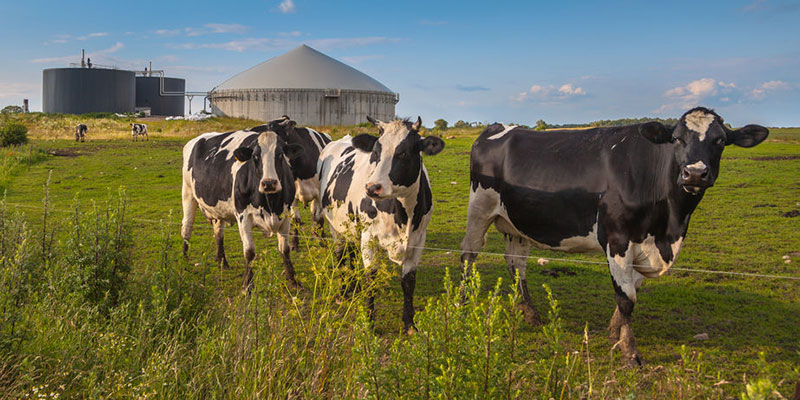Using anaerobic treatment with high-COD wastewater can yield significantly more power than the process uses.
In the continent’s quest for a carbon-neutral economy, adoption of anaerobic waste-to-energy technology has been surging
When it comes to the energy in wastewater, for far too long the world has figuratively been throwing the baby out with the bathwater. In general, wastewater contains five times more energy that it takes to treat it. Although waste-to-energy (WtE) technology is readily available, adoption of this revenue stream has been slow. But Europe recently has been moving to use the technology to progress toward the goal of a carbon-neutral economy.
What Is Biogas?
Biogas, which is produced by anaerobic digestion, is composed of about 70% methane. In the process, wastewater is treated with microorganisms in a temperature-controlled tank without access to air. The resulting biogas is harvested from the top. From there, it can be processed to various standards, used on-site to fuel boilers or generators to power operations, or sold to generate a revenue stream.
This year, Ursula von der Leyen, president of the European Commission, announced the European Union’s new Climate Law with the bold ambition of making the EU “the world’s first climate neutral continent by 2050.” But WtE biogas system adoption was already ramping up. Even before 2020, there were more than 10,000 anaerobic digesters in Europe, and some communities have used them to virtually break free of fossil fuels. Germany’s WtE economy was the early leader for biogas adoption in Europe.
Also of note, the city of Aarhus, Denmark, is now running what may be the first energy-neutral wastewater treatment facility, serving 200,000 with 2.5 GW of electricity and heat, and producing 40% more power than it uses.
According to current data, 18 European countries are now producing biomethane and the number of European biomethane-producing plants has grown 51% in only two years, from 483 in 2018 to 729 in 2020.
Promoting Biogas in Europe
Several organizations are stepping in to promote biogas as an integral part of Europe’s transformation. REGATRACE, for instance, has started setting up a harmonized biomethane market for the entire continent. The European Biogas Association (EBA) is active in biogas promotion and predicts that by 2050, biomethane and other renewable gases will help usher in a 100% renewable energy system on and off grid the grid as part of a circular bio-economy. EBA recently singled out Fluence Italy’s Eurofish project as a success story.
Fluence Biogas Projects in Europe
With decades of experience, Fluence can tailor waste-to-energy solutions to the specific needs of a wide variety of industries. It’s often possible to add an anaerobic digestion stage to existing wastewater treatment without halting production. Here are just a few of the projects Fluence has participated in:
- With a custom-designed Fluence biogas solution, Italian agro-food processors Amadori SpA reduced operational costs while producing an effluent that meets strict European Union guidelines.
- Fluence installed a biogas operation with limited space and no pause in production for Vitalfood-Italcanditi, a producer of glazed chestnuts, candies, jams, and other ingredients for the food, bakery, and dairy industries.
- Italian biochemical company Mater-Biotech, a subsidiary of Novamont, turned to Fluence to refurbish and expand an existing facility with several solutions. In the space of a year, Fluence provided a turnkey operation with water treatment, wastewater treatment, and waste-to-energy in three treatment trains.
- Dolcissimo, an Italian confectionary company in Ossona, Milan, owned by French industrial group Novandie, turned to Fluence to establish a new treatment train in a limited space. The Fluence system produces biogas, lowers COD and nitrogen levels, and reduces solid sludge by 70% to meet challenging effluent targets.
- Award-winning Italian dairy and cheese factory Latteria e Caseificio Moro was having trouble disposing of excess whey, a byproduct of cheese production. It turned to Fluence, which was able to revamp operations to produce biogas, and the plant update was installed without pausing production.
- Fluence designed and built a complete wastewater treatment plant in five months for Consorzio Cartiere di Tivoli, an Italian paper manufacturer, to reduce energy consumption and sludge volume, and to improve the quality of effluent to comply with regulations.
In Europe and around the world, anaerobic digestion biogas production has, however, faced a limiting factor. With traditional anaerobic digestion approaches, in order to break even, it’s necessary to use large reactors and a reliably high volume of feedstock. Often, smaller operations overcome this barrier by pooling feedstock with other operations and partnering on a large anaerobic digestion reactor.
An advance in anerobic digestion developed exclusively at Fluence, however, allows even smaller operations to independently pass the break-even point for efficient biogas production. The external forced circulation (EFC) reactor allows even smaller operations to conduct biogas production without co-digestion partnerships.
The EFC reactor grew from the up-flow anaerobic sludge blanket (UASB) reactor, a high-rate system with lower hydraulic retention times than competing anaerobic digestion approaches. EFC technology improves the UASB process by adding an external pumping system to recirculate the granular sludge biomass across a larger bed, increasing contact between wastewater and the active sludge.
This leads to efficient biogas production with short retention times of six to 48 hours, even on a small scale. High-rate EFC reactors can now offer an economical way for smaller sites to benefit from sustainable biogas production.
The future of European biogas seems promising, with conservative predictions of 1,000% growth by 2030, but experts say the industry must remain tied to local economies and maintain its environmental integrity to avoid a “green backlash.” But, for now, Europe shows every indication it will keep its lead in biogas adoption. Contact Fluence to share in the biogas success story.

